Swim. Swam. Serve.
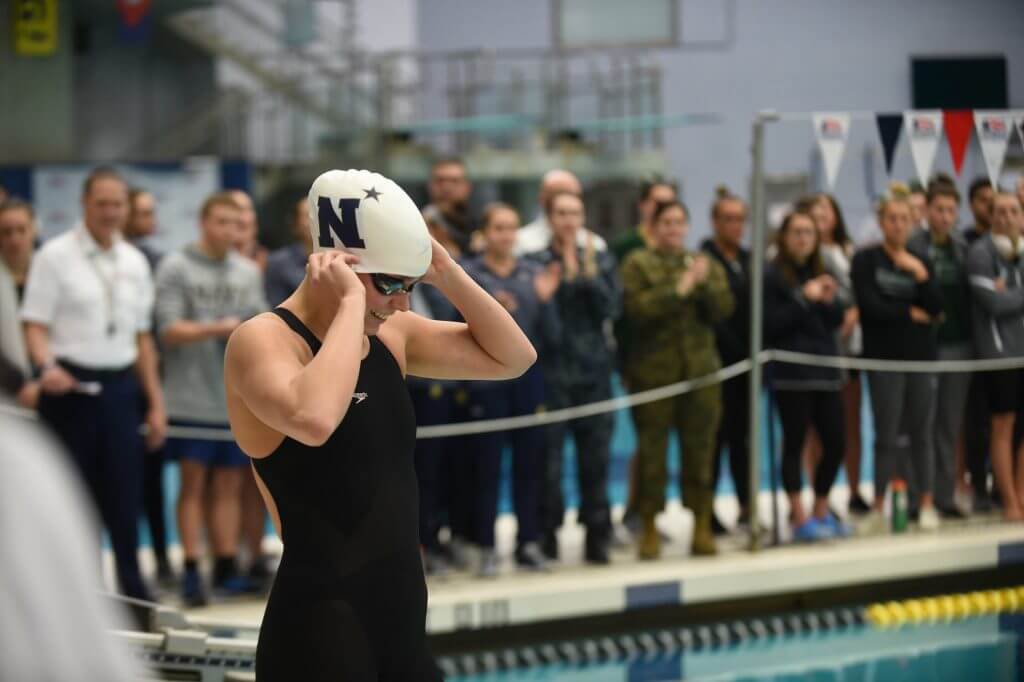
By Olivia McKelvey, Swimming World College Intern.
As the college championship season has come to a close, Swimming World had the opportunity to sit down with a unique type of student-athlete to get their take on how their day-to-day college routines have differed from others. Q&A sessions with swimmers from West Point, the Naval Academy and the Air Force Academy revealed the ins and outs of what it’s like to attend a U.S. military academy and how these athletes plan to serve our country in the future.
West Point United Military Academy
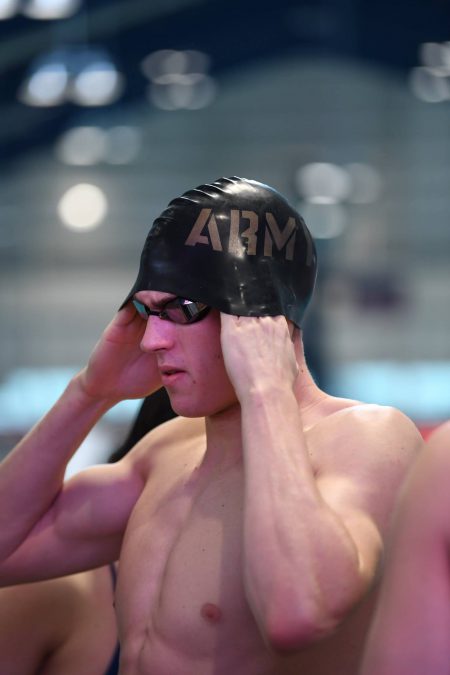
Photo Courtesy: Army Athletics
Sean Martin
Class of 2019
Hometown: Crownsville, MD
Events: 50-200 free
Major: Civil engineering
Plans after graduation: Post 60 days after graduation of declared summer leave, Martin will report to Fort Benning in Georgia to start his basic officer leader course (BOLC) training as well as attend airborne and ranger school. While at Ft. Benning, Martin will work towards becoming an infantry officer where he will serve as a platoon leader, leading soldiers into combat. After his training has concluded, he will then report to Fort Campbell in Kentucky serving within the 101st airborne division.
Swimming World: What inspired you to enroll at West Point?
Martin: When I was deciding between what colleges to attend, one thing was certain: I wanted to serve my country, but I also wanted to swim. Attending West Point and being a part of the swim team was the best option for me to combine my passions. I’m truly inspired to serve and protect my country. I come from a family with a military background. My Dad is retired from the military, and my sister graduated from West Point two years ago and is currently active duty in Korea. After graduation, I would love to be able to travel and see the world. However, I will go wherever the army needs to send me, whether that be stationed in the U.S. or serving abroad overseas where there is conflict.
SW: How is your student-athlete life different from others?
Martin: I think within all the academies – West Point, Navy, Coast Guard and Air Force – our schedules are a lot more rigid. I usually take 18 to 21 credits a semester, which in combination with my training schedule keeps me pretty busy. Even during the summer we don’t have a lot of free time to even train or practice, because we mandatory military training or other requirements. Another difference is that we have a lot more enforced activities. For example, we have mandatory meals everyday and duties like taking out the trash and cleaning our barracks. Although, these duties and other responsibilities make it seem to be a lot more to take on, I think they’re very valuable because they teach us time management and aid in dealing with stress. From an academic standpoint, classes that we take are very different from other traditional college students. Our basic 101 classes include military sciences with combat skills and boxing courses as well as a physical education curriculum in addition to what we are already doing for dryland and lifting.
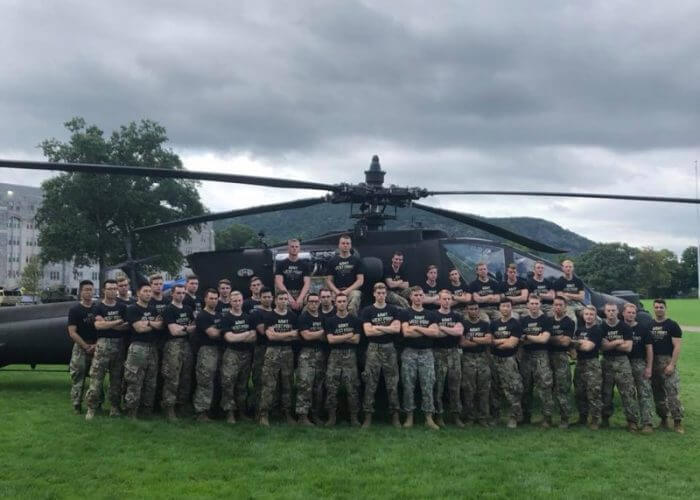
Photo Courtesy: Sean Martin
SW: What traveling and training opportunities have you experienced through West Point?
Martin: After my freshman year, I attended Air Assault school, which is essentially insertion techniques such as learning how to repel out of helicopters and more. I also spent a week at the Olympic Training Center that summer, which was a unique experience. In past summers I have also attended the Special Forces Underwater Operations Course in Key West, Fla., where I learned about stealthy waterborne infiltration, exfiltration, and other techniques to become a combat diver. Lastly, I was at Fort. Sill in Oklahoma where I shadowed a Patriot Missile Defense System platoon leader to see and learn what my job would be like within the army.
Air Force Academy
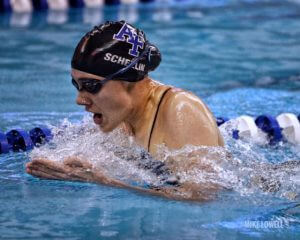
Photo Courtesy: Mike Lowell, Air Force Athletics
Heidi Schellin
Class of 2020
Hometown: Pensacola, Fla.
Events: 100 and 200 breast, 200 and 400 IM
Major: Behavior science, minor in philosophy
Plans after graduation: Would love to have the opportunity to fly or go into information operations which deals with the psychological warfare of military.
SW: What inspired you to enroll at the Air Force Academy?
Schellin: I was first intrigued by the Air Force when I learned about what the academy was through some of my prior club teammates that went on to attend the Air Force. I thought what they were doing was really cool and something I could see myself being a part of. My father is a Marine Corp pilot, so I grew up around the military. That aspect of combining military within my college and academic choices was not intimidating to me. I also was able to visit the campus on a recruiting trip, and I instantly fell in love with the beauty and architecture of the academy. Finally, I saw that everyone else was so motivated to be contributing to a bigger cause, and that made me want to take the leap into joining the United States Air Force Academy.
SW: How is your student-athlete life different from others?
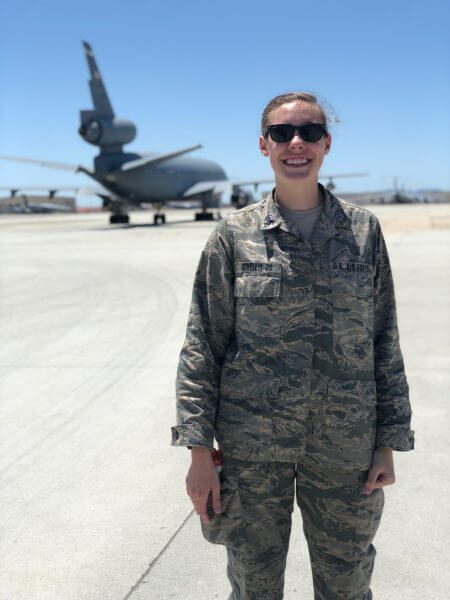
Photo Courtesy: Kendal Lewis
Schellin: In regards to scheduling, our days alternate as what we refer to as M-days and T-days. On M-days, we experience something that other college students don’t, which is Morning Officer Development (MOD). Essentially, it’s a brief overview of what the week ahead looks like. While other college students might be grouped by class in on-campus housing or other characteristics, at the Air Force, we identify by our squadrant. For example, I am an element leader, a public affairs non-commission officer and a counselor withing the 32nd quadrant which contains approximate 109 people.
All our classes are 53-minute-long periods, and on average, an Air Force student probably takes 18 to 21 credits a semester. Our curriculum structure is not always typical of all other college students, because we have to take military classes such as military strategic studies, combative skills as well as a period devoted to military time that deals with honor lessons or preparation for training. T-days, on the other hand, remain fairly similar except we march to mandatory lunch. Other small changes that I think the Air Force enforces that others might take for granted at a different university is that we are not allowed to have a car on campus, and freshman year we are not allowed to wear civilian clothing until recognition, which is in late winter. Lastly, our overall class rank is not solely based on GPA: We have other components that weight in, such as our military and physical performance averages.
SW: What does it mean to be a part of the United States Air Force?
Schellin: It is a legacy more than anything. The Air Force may not be as big or as new as the Navy or the Army, but we all share a common purpose of serving our country. At the Air Force, I’m reminded every day of the sense of camaraderie and the sacrifice that those in the past have made. Whether I’m on my way to class and pass by the class crest wall or cross paths along my way to the memorial of those who have died in combat through the Air Force, I’m constantly reminded that I’m apart of an organization that is here to honor and serve the nation.
Naval Academy
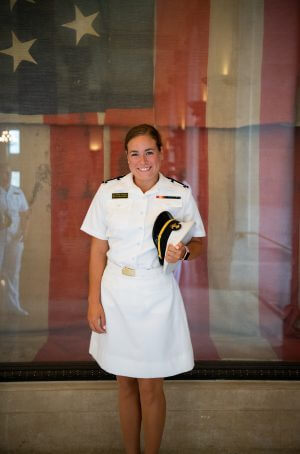
Photo Courtesy: Mckenna Resconich
Mckenna Resconich
Class of 2020
Hometown: Brighton, Mich.
Events: IM/Breastroke
Major: Quantitative economics
Rank/position: 2/C (second class midshipman)
Plans after graduation: After I graduate I would like to head down to Pensacola Florida for flight school to become a Navy Pilot or Naval Flight officer. I’d also like to get a MBA at some point so that when I get out of the academy I can pursue a career in Finance or something involving Economics. I haven’t planned too far into the future considering my commitment to be a pilot would be about ten years.
SW: What inspired you to enroll at the Naval Academy?
Resconich: Growing up in Michigan, I was not exposed to the military at all. I first heard of it when my uncle told me what it was when he saw that the Naval Academy had contacted me for swimming. I looked into it and saw what great opportunities it offered. If I’ve learned anything from attending the Naval Academy, it is that although it may be tough, it’s definitely going to be worth it. The Navy will set me up very well for the future.
SW: What does a typical day look like for you?
- 5:30-6:45, Morning Practice
- 7:20-7:45, Breakfast
- 7:55-11:45, Classes
- 12:05, Noon meal formation
- 12:15-12:35, Lunch
- 13:30-15:20, Classes
- 15:45-18:15 Swim practice
- 18:30-1900, Dinner
- 20:00-23:00, Study period (homework time)
- 23:00 Taps (mandatory sign-out sheet stating that we are in for the night and will not leave)
*We are only allowed to leave campus, aka “the yard,” Friday afternoon through Sunday.
SW: What do your summers and summer swim training consist of?
Resconich: I have a professional training related to the Navy, a leadership training and a couple weeks at home during the summer. This past summer I had a navy training called Protramid in San Diego, where you get to spend a week with four communities (surface warfare, aviation, submarines, and Marine Corps). Then, I was a Philmont Scout Ranger at Philmont Boy Scout Ranch in New Mexico. I usually try to swim a little on my training but also swim during the month when I am at home. It’s often hard to fit swimming into your summers. Last summer, I was able to attend a swim meet in Santa Clara, Calif., which was a unique experience!
SW: What does it mean to be a part of the women’s naval academy swim team?
Resconich: Being a part of the Navy women’s swim and dive (NWSD) team has definitely been an honor. The girls never fail to push one another to be the best swimmers and Midshipmen that they can be. There are days when it’s very tough, because things at school/military events are very busy, but we try our hardest to separate the pool and the yard during the week. We swim to honor those who have come before us, and there’s nothing better than being a part of America’s swim meet (the Army/Navy swim meet).
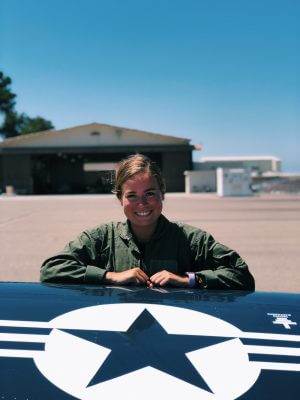
Photo Courtesy: Mckenna Resconich
All three of these individuals represent a small portion of swimmers who have made a commitment beyond the label of student-athlete. Their responsibilities go far beyond just attending class and practice, maintaining good grades and cultivating a social life. They have the commitment to later serve and protect this nation. Swimming World extends its gratitude to the men and women whom each of these academies has developed. While every collegiate swimmer does face ups and downs and other struggles, may it be noted that the men and women of the West Point Academy, the Naval Academy, and the Air Force Academy have a different type of college experience that many of us peers may have overlooked.
-All commentary and research was conducted by the the author and do not necessarily reflect the views of Swimming World Magazine nor its staff.




That was interesting. Thanks to you all.
Go Army,
Go Navy!
You guys are great!
Proud of all our services, but GO ARMY!
Love love love. Go Navy!!!
This is great!!
Excellent article! Amazing young men and women …….selfless to serve and determined. Great to see!
Thank you Swimming World Magazine for giving a little spotlight on these dedicated athletes! They do not always get the recognition within the swimming community because their military training and responsibilities often limit their ability to train in their sport like others do or to compete in the way others do where swimming news is often generated from. In each of the academy’s, military responsibilities come first. When you put a face to an athlete who will serve this country; quite possibly being put in harms way it makes it so much more personal when we see military tragedies reported in the news. I stand and applaud these individuals for their dedication, honor, and willingness to serve! (My son attended & swam for the Naval Academy sooo, GO NAVY! :-))
This is a really great and informative article, but 40% of the service academies were left out. Both the Coast Guard and Merchant Marine Academy have NCAA swimming and diving programs. Go Mariners!